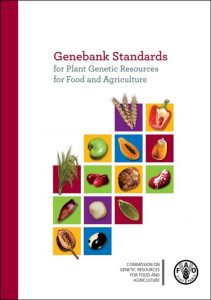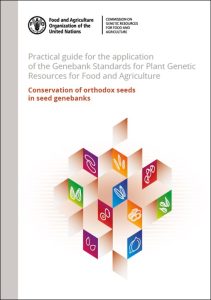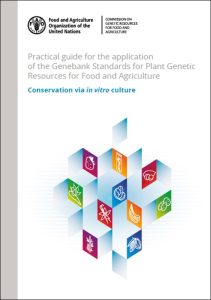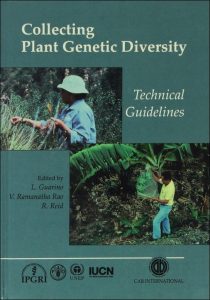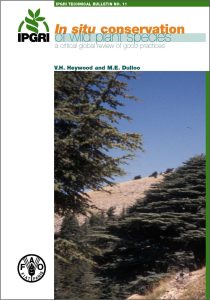Links to Some Published Best Practices for Genebanking
Gayle M. Volk, USDA-ARS National Laboratory for Genetic Resources Preservation, 1111 S. Mason St., Fort Collins, Colorado, 80521 (Gayle.Volk@usda.gov)
Outline
- Introduction
- Best practices for genebanking
- Best practices for wild species conservation
- Best practices for seed banking
- References
- Acknowledgments
1. Introduction
Best practices for plant genebanking, seed banking, and conservation have been published by multiple organizations. Herein, we provide information from the table of contents from a few of these publicly available documents that may pertain to conservation of crop wild relatives. For an expanded version of this guide that includes resources relating more broadly to plant genetic resource genebanking, visit the chapter Online Resources for Genebanking Best Practices in the eBook Fundamentals of Plant Genebanking.
2. Best practices for genebanking
Genebank Standards for Plant Genetic Resources for Food and Agriculture
The Commission on Genetic Resources for Food and Agriculture published “Genebank Standards for Plant Genetic Resources for Food and Agriculture” (FAO, 2014).
1. Introduction
2. Underlying principles
3. Standards-Structure and definitions
4. Genebank standards for orthodox seeds
5. Field genebank standards
6. Genebank standards for in vitro culture and cryopreservation
Practical guide for the application of the Genebank Standards for Plant Genetic Resources for Food and Agriculture
In 2022, the Commission on Genetic Resources for Food and Agriculture released three companion volumes to support their previous publication, “Genebank Standards for Plant Genetic Resources for Food and Agriculture” (FAO, 2014). Part 1 is “Conservation of orthodox seeds in seed genebanks” (FAO, 2022a).
1. Introduction
2. Acquisition of germplasm
3. Drying and storage
4. Seed viability monitoring
5. Regeneration
6. Characterization
7. Evaluation
8. Documentation
9. Distribution
10. Safety duplication
11. Personnel and security
12. Infrastructure and equipment
13. References cited
14. Further information/reading
Part 2 is “Conservation in field genebanks” (FAO, 2022b).
1. Introduction
2. Choice of location of the field genebank
3. Acquisition of germplasm
4. Establishment of field collections
5. Field management
6. Regeneration and propagation
7. Characterization
8. Evaluation
9. Documentation
10. Distribution
11. Safety duplication
12. Personnel and security
13. Infrastructure and equipment
14. References cited
15. Further information/reading
Part 3 is “Conservation via in vitro culture” (FAO, 2022c).
1. Introduction
2. Acquisition of germplasm
3. In vitro culture and slow-growth storage
4. Recycling and rejuvenation
5. Characterization and evaluation
6. Documentation
7. Distribution
8. Safety duplication
9. Personnel and security
10. Infrastructure and equipment
11. References cited
12. Further information/reading
Collecting plant genetic diversity: Technical guidelines
The Crop Genebank Knowledge Base provides access to each chapter of the Bioversity International publication “Collecting plant genetic diversity: Technical guidelines. 2011 update” (Guarino et al., 2011).
After Vavilov: Collecting germplasm in the 21st century
1. A brief history of plant germplasm collecting
2. Legal issues in plant germplasm collecting
3. An introduction to plant germplasm exploration and collecting: planning, methods and procedures, follow up
4. Assessing the threat of genetic erosion
5. Basic sampling strategies: theory and practice
6. Strategies for the collecting of wild species
7. Classifications of infraspecific variation in crop plants
8. Sources of information on existing germplasm collections
9. Published information on the natural and human environment
10. Published sources of information on wild plant species
11. Aids to taxonomic identification
12. Secondary sources on cultures and indigenous knowledge systems
13. Published information resources for plant germplasm collectors
14. Ecogeographic surveys
15. Mapping the ecogeographic distribution of biodiversity and GIS tools for plant germplasm collectors
16. Mapping the ecogeographic distribution of biodiversity and GIS tools for plant germplasm collectors (continued)
17. Plant heatlh and germplasm collectors
18. Collecting plant genetic resources and documenting associated indigenous knowledge in the field: a participatory approach
19. Collecting and recording data in the field: Media for data recording
20. Collecting and handling seeds in the field
21. Collecting vegetatively propagated crops (especially roots and tubers)
22. Collecting vegetative material of forage grasses and legumes
23. Collecting woody perennials
24. Collecting in vitro for genetic resources conservation
25. Collection pollen for genetic resources conservation
26. Collecting symbiotic bacteria and fungi
27. Collecting herbarium vouchers
28. Processing of germplasm, associated material and data
29. Reporting on germplasm collecting missions
30–39. Case studies
40. Collecting DNA for conservation
41. Gap Analysis: A tool for genetic conservation
3. Best practices for wild species conservation
In situ conservation of wild plant species
IPGRI Technical Bulletin No. 11, “In situ conservation of wild plant species a critical global review of good practices” provides information on best practices (Heywood and Dulloo, 2005).
Part 1. Concept, approach and actors of species-based in situ conservation
Part 2. In situ conservation methodologies
Part 3. Global survey of in situ conservation activities—good practices and case studies
Part 4. The way forward, conclusions and recommendations
4. Best practices for seed banking
Center for Plant Conservation Best Practices
The Center for Plant Conservation provides a variety of resources including “CPC Best Plant Conservation Practices to Support Species Survival in the Wild” (CPC, 2019).
Part 1. Conventional Seed Banking to Support Species Survival in the Wild
A. Introduction (The difference between orthodox, intermediate and recalcitrant seed)
B. Collecting seeds from rare plant populations
C. Splitting samples for safety duplication storage and testing
D. Cleaning, processing, drying, and storing orthodox seeds
E. Curating small samples: Increasing the number of seeds for storage and restoration
Part 2. Alternatives to Conventional Seed Banking
A. Introduction (What are alternatives to conventional seed banking?)
B. Collecting and maintaining exceptional species in tissue culture and cryopreservation
C. Field genebanks or inter situ collection
Part 3. Genetic guidelines for acquiring, maintaining, and using a conservation collection
A. Introduction (The importance of representing genetic diversity)
B. Genetic guidelines for acquiring a conservation collection
C. Genetic guidelines for maintaining a conservation collection
D. Genetic guidelines for using portions of the conservation collection for reintroductions and other purposes
Part 4. Rare plant reintroduction and other conservation translocations
A. Introduction (The goal of rare plant reintroduction)
B. Justifying and deciding whether to conduct a reintroduction or other conservation translocation
C. Preparing the reintroduction
D. Implementing the reintroduction
E. After the installation
Part 5. Documentation and data sharing
A. Introduction (The importance of documenting conservation actions)
B. Documentation
C. Distributing samples and information
5. References
CPC. 2019. CPC Best Plant Conservation Practices to Support Species Survival in the Wild. Center for Plant Conservation, Escondido, California, USA.
FAO. 2014. Genebank Standards for Plant Genetic Resources for Food and Agriculture. Revised edition. Food and Agriculture Organization of the United Nations, Rome.
FAO. 2022a. Practical guide for the application of the Genebank Standards for Plant Genetic Resources for Food and Agriculture: Conservation of orthodox seeds in seed genebanks. Commission on Genetic Resources for Food and Agriculture, Rome.
FAO. 2022b. Practical guide for the application of the Genebank Standards for Plant Genetic Resources for Food and Agriculture: Conservation in field genebanks. Commission on Genetic Resources for Food and Agriculture, Rome.
FAO. 2022c. Practical guide for the application of the Genebank Standards for Plant Genetic Resources for Food and Agriculture: Conservation via in vitro culture. Commission on Genetic Resources for Food and Agriculture, Rome.
Guarino L, Ramanatha Rao V, Goldberg E, (editors). 2011. Collecting Plant Genetic Diversity: Technical Guidelines—2011 Update. Bioversity International, Rome. ISBN 978-92-9043-922-6.
Heywood VH, Dulloo ME. 2005. In situ conservation of wild plant species: a critical global review of best practices. The International Plant Genetic Resources Institute (IPGRI) Technical Bulletin 11. IPGRI, Rome.
6. Acknowledgments
Citation: Volk GM. 2020. Links to Some Published Best Practices for Genebanking. In: Volk GM, Byrne P (Eds.) Crop Wild Relatives in Genebanks. Fort Collins, Colorado: Colorado State University. Date accessed. Available from https://colostate.pressbooks.pub/cropwildrelatives/chapter/published-best-practices/
Editors: Emma Balunek, Katheryn Chen, Gayle Volk
This training module was made possible in part by funding from USDA-ARS, Colorado State University (CSU), IICA-PROCINORTE (procinorte.net), the National Academy of Sciences (NAS), and the United States Agency for International Development (USAID). Any opinions, findings, conclusions, or recommendations expressed in such are those of the authors alone, and do not necessarily reflect the views of USDA, CSU, PROCINORTE, NAS, or USAID. USDA is an equal opportunity provider, employer, and lender.


